Forevercrombie
Keywords: A&F, A&F Quarterly, abercrombie & fitch, Akihisa, Algae, All-American, Christen Mooney, Edward Charles Duepner, Eric Jamieson, Joyce NG, Kenny, Matt Landis, Mike Jeffries, Natasha Stagg, New York Model Management, Patric DiCaprio, Red Model Management, Walter Pearce
How Abercrombie got cool, again...

In 2006, the CEO of Abercrombie & Fitch, Mike Jeffries said that sex appeal is “almost everything.” He went on to say:
“That’s why we hire good-looking people in our stores. Because good-looking people attract other good-looking people, and we want to market to cool, good-looking people. We don’t market to anyone other than that. In every school there are the cool and popular kids, and then there are the not-so-cool kids. Candidly, we go after the cool kids. We go after the attractive all-American kid with a great attitude and a lot of friends. A lot of people don’t belong, and they can’t belong. Are we exclusionary? Absolutely. Those companies that are in trouble are trying to target everybody: young, old, fat, skinny. But then you become totally vanilla. You don’t alienate anybody, but you don’t excite anybody, either” (Salon)
Allow me to play devil’s advocate: He’s right, and he can’t help that. Even the brands that don’t strive for mainstream or uptown cultural capital struggle with losing sight of their target, once they lose control of advertising. Maison Martin Margiela, Isabel Marant, and Rick Owens are decidedly avant-garde brands, and their clout was comfortably contained within the “downtown” community, until recently. That is to say, they were not target brands for small-time thieves before they were popularized by A$AP Rocky in his music. The same can be said about Prada before Jay-Z mentioned it, Manolo Blahniks before Sex and the City, and the list goes on, linking label/logo/patented color shout outs to sales/theft increases/decreases. Some manufacturers have chosen to publicly embrace a mainstreaming of their brand’s trademark (the name of the house, rhymed with catchy lyrics, or a signature piece, worn in a way that synchs only with an ostentatious lifestyle) by placing product or dressing celebrities, while others have minor meltdowns. Each approach comes from a place of true desperation, in a moment of warranted panic.

The goal is always to make a brand iconic, and to sell the iconic feeling to a person who can afford to pay too much for it. It doesn’t matter who that person is, it just matters that the customer doesn’t get so obsessed with the image with which they are provided that they are persuaded to steal it. Which brings us back to Abercrombie. Since its start, this brand was never luxury, and it wasn’t even very expensive, although it could have been cheaper. In its late nineties heyday, A&F was the brand that made sexy versions of the clothes kids already wore to school—comfortable T-shirts and jeans, stuff you could toss a football in, or change out of… something you could throw on the grass if everyone was skinny dipping—but it was better than the cheaper versions of this. It was a name that said fitness, youth, and casual sex. It was exactly what the popular kids in school needed: not their father’s country club attire, and not something as feminized as Delia’s or as political as Nike.

This was the golden age of the original, when kids needed Louis Vuitton luggage, Gucci glasses, and Starbucks in the cup holder on the way to school. Knockoffs were everywhere but imitations were unacceptable: even your energy drink had to be a clean, narrow Redbull, unless you were part of the Monster alternative crowd. Clothing was another question. No one wanted to wear a Lagerfeld to school, because school sucked, and so did anyone who tried too hard, especially the weirdos. Competing with sports brands and the free shirts given out at pep rallies, A&F had to become a lifestyle brand if they wanted to become truly top-tier in the empty space above a 1990s sloppy flannel wardrobe, which was running middle-America.
When A&F Quarterly was born, it was packaged like porn in brown paper, and shipped to teenagers. Sex scenes shot by the famously homoerotic Weber influenced the first feelings of arousal in many youths, mostly in the Midwest. A new youth culture arose: Maybe the uptown cufflink wearers or the Hollywood high heels actually weren’t the hottest people on earth to the people who had never seen them: Maybe blissful, perfect sex was available at camp, or in back yards. And maybe the reason kids hadn’t had the key to that exclusive club yet was because they weren’t dressed for it.

Ironically, the controversy caused by the catalogues was not very focused on how homosexual the images were. Parents were upset about their kids seeing porn at all, and then begging to buy the clothes associated with it at the mall—out of a nightclub-like store, bumping bass-heavy music and guarded by hard-bodied male greeters. This was before the internet was accessible enough for teens to search watchable porn, or fast enough to get a full experience with it. A&F became the thing that parents warned their kids against: it was as naughty as hooking up or doing drugs, but hardly as dangerous. Thus, the lifestyle brand—complete with fragrance and friendship bracelets—was, at its height, as popular as it ever wanted to be, with just a few thefts to worry about. No big deal, since the sales made up for them, seeing as they were pricing stuff much higher than their cheaper lines of almost identical clothes.
I never would have guessed that Abercrombie & Fitch would be so much in the news again. It just felt really over, which was why it could be embraced by all the people it used to hate on. We can finally look at the sexy pages of A&F Quarterly and admire it as simple propaganda. In these beautiful pages, there were hardly any clothes on the models, so ordering an outfit came last, and no one really looked at what they were buying. But news items like this one, which points out that people are still outraged by every little thing A&F does, confuse the company into thinking that they still have sway. Taylor Swift fans (“Swifties”) hate that the mall store put out a shirt poking fun at the romantically challenged pop-country singer’s growing boyfriend count. Never mind that the shirt’s message, in trying to be a relevant as a shirt can possibly be, has missed the mark by making a hashtag with spaces and punctuation (every Swiftee and Swiftee-age internet user knows that a hashtag broken up is a hashtag broken), in all lowercase letters. Since no one calls Taylor Swift t.s., one may be inclined to assume this shirt mentions the modernist poet famously in favor of abolishing capital letters, t.s. eliot, making this one of the least relevant shirts I’ve ever seen.

Remember, in high school, when all the white boys would wear the shirts that said “Wok-n-Bowl” and “Wong Brothers Laundry Service: Two Wongs Can Make it White,” accompanied by cartoons that could have been on a WWII propaganda poster? Back then, in the early 2000s, all of it was deplorable, if you were on the other side of things. Meaning, if you weren’t part of the in-crowd, straight, and white. Now, the only people I see wearing this brand are Asians and gay people. The take-back may not be very calculated—not as calculated as ‘the n-word’ re-meaning, or new burlesque culture, at least—but it seems pretty obvious that the once-protestable racism, misogyny, and elitist ways of a brand have given it the cred to fill out its next stage. Like when golf and polo outfitters Tommy Hilfiger and Ralph Lauren became so knocked-off and collected by urban kids, new versions of the brands were launched specifically for the urban kids.
Of course, each high-end clothing morph included some growing pains. There was that rumor that Tommy said he hated black people wearing his clothes, and there were the Lo Lifes—a subculture made up of people who only wore Polo, and never purchased it. There was that Cristal quote about rappers promoting the champagne as part of a “bling lifestyle”: (“what can we do? We can’t forbid people from buying it” [The Economist]) and Burberry’s annoyance with the middle class adopting its signatures, and ever so many more examples of luxury brands getting choosy about their customers. This strategy itself isn’t necessarily racist or bigoted, although it comes off that way, and sometimes the spokespeople for the brands do, too, probably because they are.

In high school, like so many scenes in the movies suggested, there was (is) a class system. The tables in the cafeteria are designated to different groups that range in popularity. There are nerds of different sorts—in the 2000s there were those dressed as nerd-heroes (of Hackers, The Matrix, etc), and then there was every other kind of nerd, who tried to camouflage his or her behavior with inconspicuous clothing. This meant T-shirts and jeans, but even a plain pocket T with Lees or Levis would stand out as a clueless attempt to blend in. Shirts that said “America,” or something as unassuming replaced any minimal efforts, but then the emblems would easily give away the wearers. Popular kids could spot nerds easily because their Old Navy logos looked cheap, which meant they didn’t care about looking good, which meant they were probably virgins. But if you wore Bebe or Coach—anything more expensive than Guess—you weren’t as easy-going and DTF as the perfect medium, and possibly also a virgin.

The best specimens played sports, but could also do a lap dance. They were motivated enough to get up and get on the pontoon boat, at the lake, on summer days, at 9am, but they were relaxed enough to enjoy the next several hours floating on it. These were the Abercrombie kids: aggressive enough to snowboard, date rape, and shame the Algebra teacher by telling a mean joke in class, but projecting that they were okay with whatever, presumably taking what they dished out, if anyone stepped up to the plate. They weren’t as passive as stoners and skaters, who had their own set of signifiers. They were specific, and needed specific branding. Abercrombie’s was so strong it was part of the chorus in 1999’s hit “Summer Girls,” by Lyte Funky Ones. In fact, a checkpoint of a generation, that whole song is random pop-culture references from the 1980s and 90s, but the most memorable lyric is tinged with racism: “I like girls that [sic] wear Abercrombie and Fitch / Chinese food makes me sick.”
By that time, the 1990s were ending and popular movies had left us with a few variations of the same lesson: Never trust anyone except yourself, and be especially wary of grownups. Teaching Mrs. Tingle, Disturbing Behavior and The Faculty depicted the evil inside each adult, and made us more fearful of aging than any preceding generation. Just look at what happened to the most rebellious teens before us: they are all working for The Man they once protested, and now they’re telling us not to listen to rap music. There were two groups then: kids wanted to be in with Abercrombie, and kids who hated it. To everyone who hated it, the brand represented the staggered systems of upward mobility and whitewashing. It was a group who ridiculed (again, ironically) gays, minorities, and even the too pale or the too thin. Of course, fat people were not allowed (but where have they ever been welcomed, over others?). The brand was like boy bands and girl groups of the time: all-play no-work cliques, who were sexy and safe within the screen or page. But where were the kids with acne? Where were these adults who wanted nothing but to bum us out, in these music videos and mall stores? They were lurking in the shadows the whole time, and it was the industry’s job to keep them at a distance. Only the dumbest of teens couldn’t accept that the people protecting them from the evil adults were adults themselves—and the most evil out of everyone, owning sweatshops and committing fraud. But the dumbest teens turned out to also be the hottest.

In 2006, it was discovered that Lou Pearlman—manager of The Backstreet Boys, ‘N Sync and Lyte Funky Ones—was running one of the country’s biggest Ponzi schemes on record. And by 2006, Mike Jeffries’ most controversial public statement on sex appeal was really just saying what we were all thinking. “…Candidly, we go after the cool kids. We go after the attractive all-American kid with a great attitude and a lot of friends. A lot of people don’t belong, and they can’t belong. Are we exclusionary? Absolutely…”
It’s like what your parents always said to you about your abnormalities (whatever they may have been/are): they’re blessings, because you won’t have to find out the hard way who your real friends are, since no one shallow would ever befriend you. The same mentality can be transferred onto the A&F signage all over the jocks and their girlfriends (not the cheerleaders; they were sluts). We didn’t have to find out the hard way that they weren’t friendable—it said so on their shirts. And it also said business: caring more about a quality of life than the quality of all lives is a priority all business-school students have already made. Advertising that you are interested in business—that you will make money one day—is almost like advertising success. Advertising that you hated A&F was saying you took the moral high ground, whether it involved failure or not.

Anyway, A&F couldn’t stay popular forever, but it did have a good run. And now wearing A&F ironically is all over the internet (Google it: there are plenty of Tumblrs, DIY photo shoots and performance art projects devoted to defaming the brand by wearing it as an “outsider”). There are now knockoff Abercrombie clothes—a fate the “casual luxury” brand once assumed they could avoid. Actually, the brand stole its name and rustic identity from a bankrupt fishing and sporting goods company founded in 1892. A&F as we know it started in 1988, and was almost immediately copied by other mall stores like American Eagle and Aéropostale. I don’t have to tell you that since the remarks made by Jeffries and since lawsuit after lawsuit, mostly involving discrimination in staffing of storefronts, and since announcing they will not carry anything over a size 10, sales for Abercrombie & Fitch have decreased. What may not be as obvious is that worldwide, if we’re to include knockoffs (we can call the wearers of faux A&F the brand’s cheerleaders, if not part of the official team), it’s probably doing well despite its rumored collapse, the same way American Apparel, after all that talk of bankruptcy, has. Amer-pare has stayed afloat mostly because no matter how offensive the brand is, the clothes are innocuous. A&F on the other hand, has come to represent a late-nineties excess met with endless access. The song “Summer Girls” may not attract the same type of girl it once did, but it stays stuck in the head of the girl it originally enticed. The A&F logo is all over Asia as a symbol of American laziness, which is still enviable to many. Like Juicy Couture and Baby Phat, their sweatpants truly are casual luxury, with a history behind them that proves how dangerous this mindset is.

Like the tongue-in-cheek rips on luxury brands like fake Balmain shirts that instead say “Baller,” Comme des Garçons-style fonts that say “Comme des Fuck Down,” etc., someone who could never live up to an Abercrombie ad wearing an Abercrombie outfit is a subtle burn. A certain type of gay man has been wearing it head-to-toe since A&F Quarterly came out (no pun intended), even if he was never exactly the key demographic. And since the Wok-n-Bowl shirts were taken out of circulation after a complaint was filed, the Asian population have agreed to forgive and forget—or at least reappropriate the logos in a way that gets a new point across, the way dressing in head-to-toe Tommy Gear or getting tattooed with the Chanel double-Cs would.
Although A&F, the company, had an idea of who they wanted—limiting wearers to the few who had not only the privilege of wealth, but robust looks—their fantasy world became too enticing. A&F the image presented many with a sexual awakening, and a pride in American greed. Instead of creating a brand that was reachable, desirable, and elitist, it created a frenzy of horny teens who did steal it (because their parents refused to buy the over-sexed and/or corrupt brand). And now that the mall, overall, looks more Hot Topic than Old Navy, wearing the “All-American” made-in-China brands looks a little subversive. In a way, wearing A&F now is as punk as wearing Sharpie-written anti-Abercrombie shirts was in the 2000s—but with layers as plentiful as the tanks and tees worn under non-regulation spaghetti straps to school. Go ahead: try and not get away with that.

Essay Natasha Stagg
Photography DIS
Photo Assistants Ian Stoner and Ben Taylor
Styling Joyce Ng and Patric DiCaprio
Hair Eric Jamieson
Makeup Akihisa Yamaguchi
Clothes Abercrombie & Fitch
Models Matt Landis at Red Model Management, Algae at Wilhelmina, Kenny at New York Model Management, Joyce Ng, Edward Charles Duepner,
Walter Pearce, and Christen Mooney